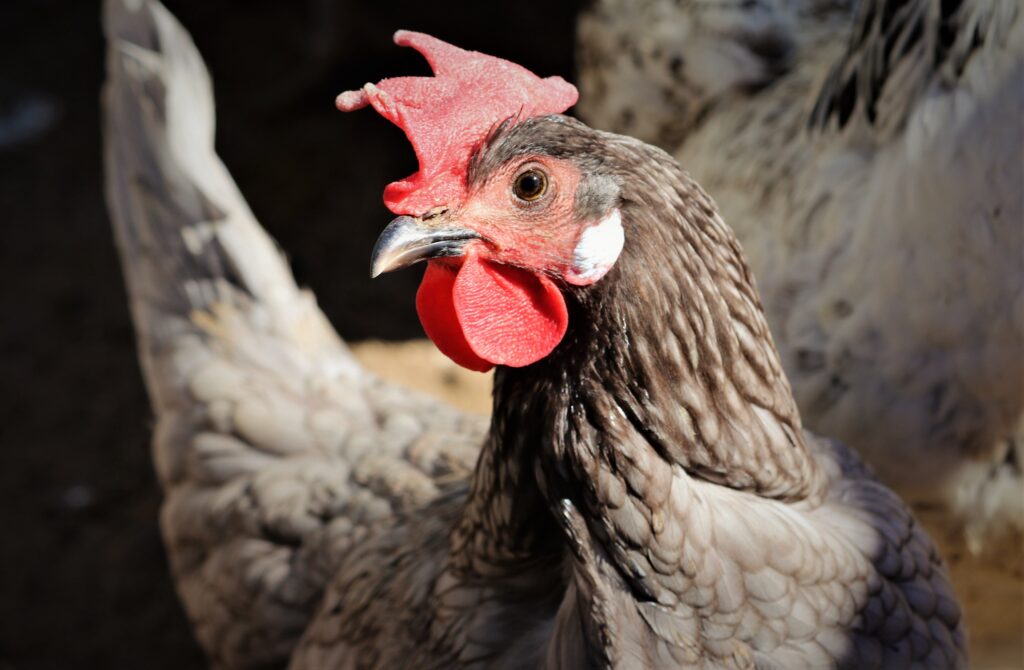They’re kind of funny looking and if you don’t already know their names, you probably don’t know what purpose they serve. Some are bigger, and some are smaller. Some have a rich color while others are paler. What are the red things on a chicken’s head? Let’s find out!
What Are the Red Things on a Chicken’s Head?
It depends on which red things you’re talking about when you ask what the red things are on a chicken’s head. If you are referring to the mohawk-like red thing on a chicken’s head, that’s the comb. If you’re referring to the red things that hang on either side behind a chicken’s beak, those are wattles!
Understanding Combs
Combs are fleshy and bright red. They appear a lot like the unique mohawk hairstyle. Some combs are shorter while others are taller. Their primary purpose is display but it also helps chickens remain cool when the weather gets toasty. You can always tell the difference between a hen that is laying and one that is not. When the comb is bright red and large, that means the hen is actively laying eggs. However, if a hen’s comb is more of a pinkish color and is noticeably smaller, the hen is not laying.
You typically see pink and red as the colors of a chicken’s comb, but they may also appear dark (like with silkies) or purple. Their appearance is communicative and because they’re comprised of collagen fibers, they help keep a chicken’s body temperature well-regulated. When a chicken gets hot, their comb enlarges. Blood pumps faster to ensure the chicken is releasing heat and this causes the comb to grow bigger.

Combs are the mohawk-like fleshy bits on a chicken’s head.
©Guitar photographer/Shutterstock.com
What Combs Communicate
Combs divulge several pieces of information relating to the chicken’s health. Since combs respond to blood flow, the color can help you identify whether or not your chicken has circulatory issues. This is when the color is of vital importance. If it’s darker, getting closer to a purple color, and your chicken’s comb is usually a more vibrant red, it’s time to take a closer look.
Another piece of information you can collect from the appearance of a chicken’s comb is whether or not it’s plump or limp and floppy. If you notice that it’s limp, your chicken is likely dehydrated. However, this is also a sign of old age. You can also look at a chicken’s comb to determine if it has been in a fight with another flock member. If a bully is trying to ascertain the pecking order, isolate it to prevent further injury.
The chicken comb doesn’t just have messages for you. It also communicates sexual attraction. Once hormones start circulating in a chicken’s body, the comb starts shifting, growing, and becoming more vibrant. Ultimately, a good comb demonstrates strength and vitality, which makes both hens and roosters more attracted to one another. That’s not the only red thing on a chicken that communicates health and sexual maturity, however.
Exploring Wattles
The wattles are similar in appearance to the combs, but they sort of flap down on either side of a chicken’s throat. Young roosters have pronounced wattles. They signal the rooster’s health, demonstrating high testosterone and proper nutrition which makes the cockerel an attractive mate. Although they point to health and the potential for successful mating, they also help with thermoregulation the way combs do. The blood from the comb circulates lower to the wattles where it’s cooled, which keeps chickens comfortable on hot days.

Wattles are the fleshy bits that hang on either side of a chicken’s throat.
©Heather Barrett/Shutterstock.com
Wattles are like combs — their appearance should be soft and plump. In hens, they communicate the potential for good egg production. In most hens, the wattles are a vibrant red color but depending on the breed, there may be some variations. Aside from bright red, wattles may also be a rosy, pink color. When there’s a change in appearance, there may be an underlying health issue that requires prompt attention.
Significance and Function
Both combs and wattles serve important functions that are integral to the health and survival of chickens. They offer cooling, regulating the chicken’s body temperature. Chickens don’t sweat the way humans do and these plump, vibrant fleshy bits prevent them from overheating. Combs and wattles communicate the point of sexual maturity, advising of high testosterone and good egg production, which attracts mates. They also indicate the chicken’s current state of health, pointing to issues such as dehydration.
Thank you for reading! Have some feedback for us? Contact the AZ Animals editorial team.








